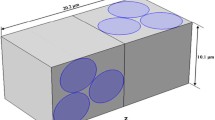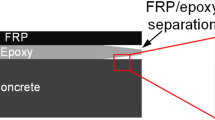Abstract
This manuscript presents a combined computational–experimental study of the mesoscale thermo-mechanical behavior of the Hydroxyl-terminated polybutadiene (HTPB) bonded ammonium perchlorate (AP) composite energetic material subjected to dynamic loading conditions. The computational model considers the AP–HTPB interface debonding, post-debonding interface friction and temperature rise due to viscoelastic dissipation as well as dissipative interfacial processes. The interface is modeled using a cohesive zone model combined with a contact algorithm to account for the interface separation, particle/binder contact and heat generation. The HTPB binder is modeled as viscoelastic with adiabatic temperature rise. Three experiments are conducted to calibrate and validate the model. Raman spectroscopy and indentation experiment are employed to determine the interface properties, whereas Kolsky bar tension test along with in-situ synchrotron X-ray diffraction measurements are used to validate the model and understand the interface separation characteristics under dynamic loading.























Similar content being viewed by others
References
Al-Rub RKA, Voyiadjis GZ (2006) A finite strain plastic-damage model for high velocity impact using combined viscosity and gradient localization limiters: part i-theoretical formulation. Int J Damage Mech 15(4):293–334
Amirkhizi AV, Isaacs J, McGee J, Nemat-Nasser S (2006) An experimentally-based viscoelastic constitutive model for polyurea, including pressure and temperature effects. Philos Mag 86(36):5847–5866
Anastassakis E, Pinczuk A, Burstein E, Pollak FH, Cardona M (1970) Effect of static uniaxial stress on the raman spectrum of silicon. Solid State Commun 8(2):133–138
Armstrong RW, Coffey CS, Elban WL (1982) Adiabatic heating at a dislocation pile-up avalanche. Acta Metall 30(12):2111–2116
Armstrong RW, Coffey CS, DeVost VF, Elban WL (1990) Crystal size dependence for impact initiation of cyclotrimethylenetrinitramine explosive. J Appl Phys 68(3):979–984
Armstrong RW, Ammon HL, Elban WL, Tsai DH (2002) Investigation of hot spot characteristics in energetic crystals. Thermochim Acta 384(1):303–313
Baer MR (2002) Modeling heterogeneous energetic materials at the mesoscale. Thermochim Acta 384(1):351–367
Balzer JE, Siviour CR, Walley SM, Proud WG, Field JE (2004) Behaviour of ammonium perchlorate-based propellants and a polymer-bonded explosive under impact loading. Proc R Soc Lond A 460(2043):781–806
Barton NR, Winter NW, Reaugh JE (2009) Defect evolution and pore collapse in crystalline energetic materials. Model Simul Mater Sci Eng 17(3):035003
Barua A, Zhou M (2011) A lagrangian framework for analyzing microstructural level response of polymer-bonded explosives. Model Simul Mater Sci Eng 19(5):055001
Barua A, Horie Y, Zhou M (2012) Microstructural level response of hmx-estane polymer-bonded explosive under effects of transient stress waves. Proc R Soc Lond A 468(2147):3725–3744
Brill TB, Caetz F (1976) Laser Raman studies of solid oxidizer behavior. In: 14th Aerospace sciences meeting, pp 1–7
Buback M, Schulz KR (1976) Raman scattering of pure ammonia at high pressures and temperatures. J Phys Chem 80(22):2478–2482
Cady CM, Blumenthal WR, Gray GT, Idar DJ (2006) Mechanical properties of plastic-bonded explosive binder materials as a function of strain-rate and temperature. Polym Eng Sci 46:812–819
Chakraborty T, Khatri SS, Verma AL (1986) Temperature-dependent raman study of ammonium perchlorate single crystals: the orientational dynamics of the NH+ 4 ions and phase transitions. J Chem Phys 84(12):7018–7027
De Wolf I (1996) Micro-raman spectroscopy to study local mechanical stress in silicon integrated circuits. Semicond Sci Technol 11(2):139
Dienes JK, Zuo QH, Kershner JD (2006) Impact initiation of explosives and propellants via statistical crack mechanics. J Mech Phys Solids 54(6):1237–1275
Duddu R, Waisman H (2012) A temperature dependent creep damage model for polycrystalline ice. Mech Mater 46:23–41
Fell NF, Widder JM, Medlin SV, Morris JB, Pesce-Rodriguez RA (1995) Fourier transform raman (ftr) spectroscopy of some energetic materials and propellant formulations ii. Technical report, DTIC Document
Field JE (1992) Hot spot ignition mechanisms for explosives. Acc Chem Res 25(11):489–496
Gray GT III, Blumenthal WR, Idar DJ, Cady CM (1998) Influence of temperature on the high-strain-rate mechanical behavior of pbx 9501. In: Schmidt SC, Dandekar DP, Forbes JW (eds) Shock compression of condensed matter, 1997, vol 429. AIP press, Woodbury, New York pp 583–586
Hanson-Parr DM, Parr TP (1999) Thermal properties measurements of solid rocket propellant oxidizers and binder materials as a function of temperature. J Energ Mater 17(1):1–48
Han B, Ju Y, Zhou C (2012) Simulation of crack propagation in htpb propellant using cohesive zone model. Eng Fail Anal 26:304–317
Hudspeth M, Claus B, Parab N, Lim B, Chen W, Sun T, Fezza K (2015) In situ visual observation of fracture processes in several high-performance fibers. J Dyn Behav Mater 1(1):55–64
Hui T, Oskay C (2012) Computational modeling of polyurea-coated composites subjected to blast loads. J Compos Mater 46:2167–2178
Hui T, Oskay C (2014) A high order homogenization model for transient dynamics of heterogeneous media including micro-inertia effects. Comput Methods Appl Mech Eng 273:181–203
Hui T, Oskay C (2015) Laplace-domain, high-order homogenization for transient dynamic response of viscoelastic composites. Int J Numer Methods Eng 103(13):937–957
Jimenez S, Duddu R (2015) On the parametric sensitivity of cohesive zone models for high-cycle fatigue delamination of composites. Int J Solids Struct 82:111–124
Lin Y, Mao WL, Drozd V, Chen J, Daemen LL (2008) Raman spectroscopy study of ammonia borane at high pressure. J Chem Phys 129(23):234509
Lucca DA, Klopfstein MJ, Mejia OR, Rossettini L, DeLuca LT (2006) Investigation of ammonium perchlorate by nanoindentation. Mater Sci Technol 22(4):396–401
Mares JO, Miller JK, Sharp ND, Moore DS, Adams DE, Groven LJ, Rhoads JF, Son SF (2013) Thermal and mechanical response of pbx 9501 under contact excitation. J Appl Phys 113(8):084904
Mares JO, Miller JK, Gunduz IE, Rhoads JF, Son SF (2014) Heat generation in an elastic binder system with embedded discrete energetic particles due to high-frequency, periodic mechanical excitation. J Appl Phys 116(20):204902
Mas EM, Clements BE, Blumenthal WR, Cady CM, Gray GT, Liu C (2002) A viscoelastic model for pbx binders. In: Furnish MD, Thadhani NN, Horie Y (eds) Proceedings of the 2001 conference of the APS topical group on shock compression of condensed matter, vol 1. American Institute of Physics, Woodbury, pp 661–664
Menikoff R, Sewell TD (2002) Constituent properties of hmx needed for mesoscale simulations. Combust Theor Model 6(1):103–125
Miller JK, Mares JO, Gunduz IE, Son SF, Rhoads JF (2016) The impact of crystal morphology on the thermal responses of ultrasonically-excited energetic materials. J Appl Phys 119(2):024903
Nallasamy P, Anbarasan PM, Mohan S (2002) Vibrational spectra and assignments of cis- and Trans-1,4-polybutadiene. Turk J Chem 26:105–111
Ninet S, Datchi F, Saitta AM, Lazzeri M, Canny B (2006) Raman spectrum of ammonia IV. Phys Rev B 74(10):104101
Oskay C (2009) Two-level multiscale enrichment methodology for modeling of heterogeneous plates. Int J Numer Methods Eng 80(9):1143
Oskay C (2013) Variational multiscale enrichment method with mixed boundary conditions for modeling diffusion and deformation problems. Comput Methods Appl Mech Eng 264:178–190
Oskay C, Fish J (2007) Eigendeformation-based reduced order homogenization for failure analysis of heterogeneous materials. Comput Methods Appl Mech Eng 196:1216–1243
Parab ND, Black JT, Claus B, Hudspeth M, Sun J, Fezzaa K, Chen WW (2014) Observation of crack propagation in glass using X-ray phase contrast imaging. Int J Appl Glass Sci 5(4):363–373
Park K, Paulino GH (2012) Computational implementation of the ppr potential-based cohesive model in abaqus: educational perspective. Eng Fract Mech 93:239–262
Peiris SM, Pangilinan GI, Russell TP (2000) Structural properties of ammonium perchlorate compressed to 5.6 gpa. J Phys Chem A 104(47):11188–11193
Rae PJ, Goldrein HT, Palmer SJP, Field JE, Lewis AL (2002a) Quasi-static studies of the deformation and failure of \(\beta \)-hmx based polymer bonded explosives. Proc R Soc Lond A 458(2019):743–762
Rae PJ, Palmer SJP, Goldrein HT, Field JE, Lewis AL (2002b) Quasi-static studies of the deformation and failure of pbx 9501. Proc R Soc Lond A 458(2025):2227–2242
Renshaw J, Chen JC, Holland SD, Thompson RB (2011) The sources of heat generation in vibrothermography. NDT E Int 44(8):736–739
Samudrala O, Huang Y, Rosakis AJ (2002) Subsonic and intersonic mode II crack propagation with a rate-dependent cohesive zone. J Mech Phys Solids 50(6):1231–1268
Schneider F, Fellner T, Wilde J, Wallrabe U (2008) Mechanical properties of silicones for mems. J Micromech Microeng 18(6):065008
Simo JC, Hughes TJR (2006) Computational inelasticity. Springer Science and Business Media, Berlin
Siviour CR, Gifford MJ, Walley SM, Proud WG, Field JE (2004) Particle size effects on the mechanical properties of a polymer bonded explosive. J Mater Sci 39(4):1255–1258
Siviour CR, Laity PR, Proud WG, Church PD, Gould P, Huntingdon-Thresher W (2008) High strain rate properties of a polymer-bonded sugar: their dependence on applied and internal constraints. Proc R Soc Lond A 464(2093):1229–1255
Studer V, Hang G, Pandolfi A, Ortiz M, Anderson WF, Quake SR (2004) Scaling properties of a low-actuation pressure microfluidic valve. J Appl Phys 95(1):393–398
Tan H, Liu C, Huang Y, Geubelle PH (2005) The cohesive law for the particle/matrix interfaces in high explosives. J Mech Phys Solids 53(8):1892–1917
Tomar V, Zhai J, Zhou M (2004) Bounds for element size in a variable stiffness cohesive finite element model. Int J Numer Methods Eng 61(11):1894–1920
Tvergaard V, Hutchinson JW (1993) The influence of plasticity on mixed mode interface toughness. J Mech Phys Solids 41(6):1119–1135
Verma D, Tomar V (2014) An investigation into environment dependent nanomechanical properties of shallow water shrimp (pandalus platyceros) exoskeleton. Mater Sci Eng C 44:371–379
Verma D, Tomar V (2015a) Strain rate dependent failure of metallic interfaces at nano-microscale via nanoimpact experiments. In: 20th International conference on composite materials
Verma D, Tomar V (2015b) A comparison of nanoindentation creep deformation characteristics of hydrothermal vent shrimp (rimicaris exoculata) and shallow water shrimp (pandalus platyceros) exoskeletons. J Mater Res 30(08):1110–1120
Verma D, Qu T, Tomar V (2015) Scale dependence of the mechanical properties and microstructure of crustaceans thin films as biomimetic materials. JOM 67(4):858–866
Winey JM, Gruzdkov YA, Dreger ZA, Jensen BJ, Gupta YM (2002) Thermomechanical model and temperature measurements for shocked ammonium perchlorate single crystals. J Appl Phys 91(9):5650–5656
Wriggers P, Laursen TA (2006) Computational contact mechanics, vol 30167. Springer, Berlin
Wu YQ, Huang FL (2009) A micromechanical model for predicting combined damage of particles and interface debonding in pbx explosives. Mech Mater 41(1):27–47
Wu X, Yu J, Ren T, Liu L (2007) Micro-raman spectroscopy measurement of stress in silicon. Microelectron J 38(1):87–90
Xu J, Chen X, Wang H, Zheng J, Zhou C (2014) Thermo-damage-viscoelastic constitutive model of htpb composite propellant. Int J Solids Struct 51(18):3209–3217
Zhai J, Tomar V, Zhou M (2004) Micromechanical simulation of dynamic fracture using the cohesive finite element method. J Eng Mater Technol 126(2):179–191
Zhang X, Oskay C (2015) Eigenstrain based reduced order homogenization for polycrystalline materials. Comput Methods Appl Mech Eng 297:408–436
Zhang S, Oskay C (2016) Reduced order variational multiscale enrichment method for elasto-viscoplastic problems. Comput Methods Appl Mech Eng 300:199–224
Zhou F, Molinari JF, Shioya T (2005) A rate-dependent cohesive model for simulating dynamic crack propagation in brittle materials. Eng Fract Mech 72(9):1383–1410
Zhou Z, Chen P, Huang F, Liu S (2011) Experimental study on the micromechanical behavior of a pbx simulant using sem and digital image correlation method. Opt Lasers Eng 49(3):366–370
Zhu Y, Liechti KM, Ravi-Chandar K (2009) Direct extraction of rate-dependent traction–separation laws for polyurea/steel interfaces. Int J Solids Struct 46(1):31–51
Acknowledgments
The authors gratefully acknowledge the financial support from the Air Force Office of Scientific Research, Dynamic materials and Interactions program (Grant No.: FA9550-15-1-0202, Program Manager: Dr. Jennifer Jordan). We thank Prof. Weinong Chen of Purdue University for allowing the use of his Kolsky bar setup at Argonne National Laboratory. We also thank Kamel Fezzaa, Tao Sun, Niranjan Parab, Jesus Mares and Zane Roberts for helping with the Kolsky bar experiment.
Author information
Authors and Affiliations
Corresponding author
Rights and permissions
About this article
Cite this article
Hu, R., Prakash, C., Tomar, V. et al. Experimentally-validated mesoscale modeling of the coupled mechanical–thermal response of AP–HTPB energetic material under dynamic loading. Int J Fract 203, 277–298 (2017). https://doi.org/10.1007/s10704-016-0141-7
Received:
Accepted:
Published:
Issue Date:
DOI: https://doi.org/10.1007/s10704-016-0141-7




